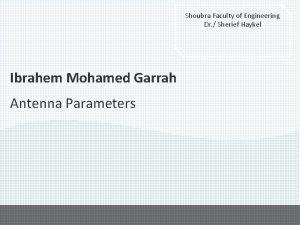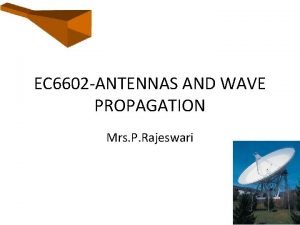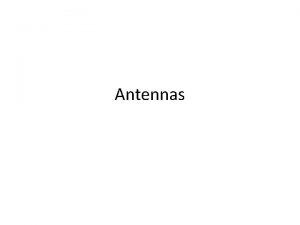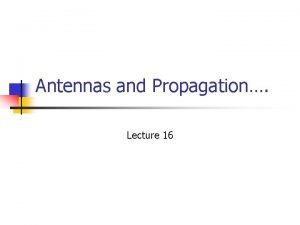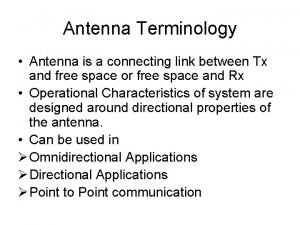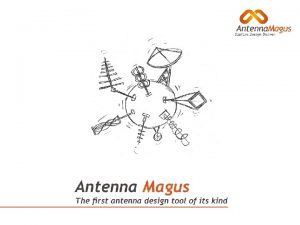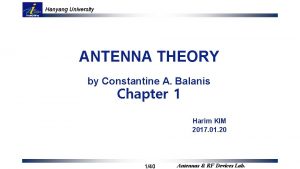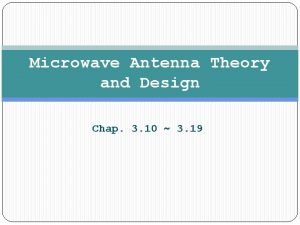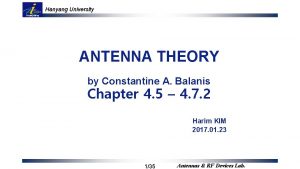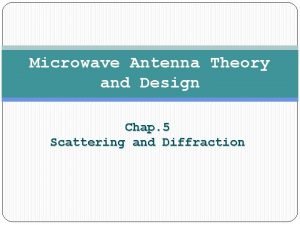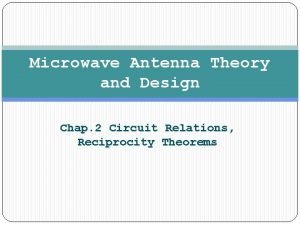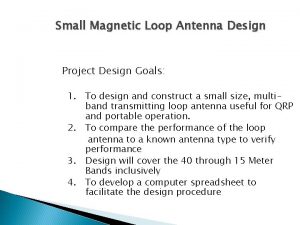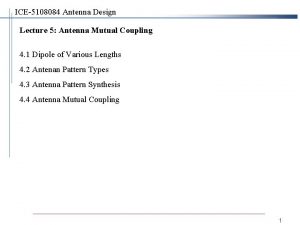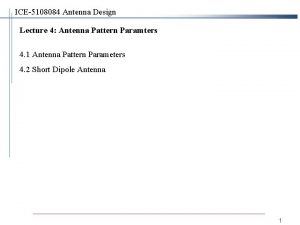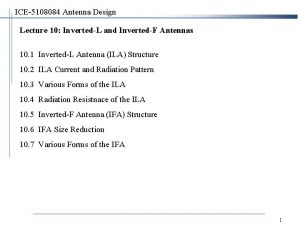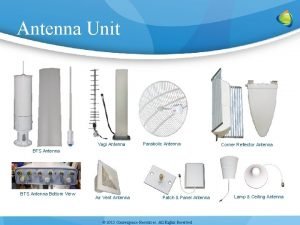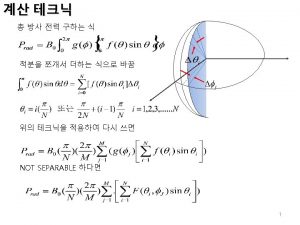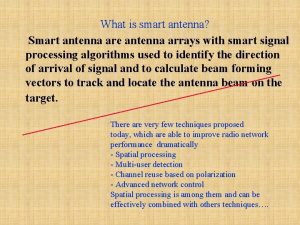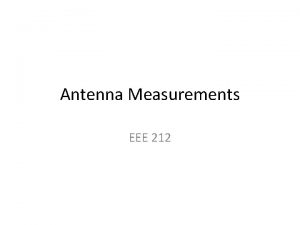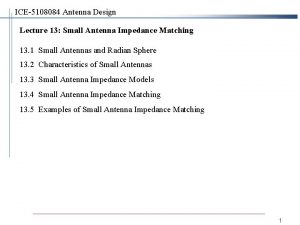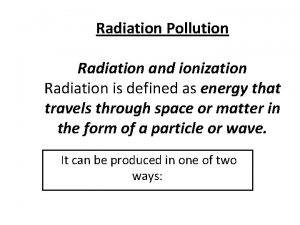ICE5108084 Antenna Design Lecture 2 Antenna Radiation and

















- Slides: 17

ICE-5108084 Antenna Design Lecture 2: Antenna Radiation and Impedance 2. 1 Antenna Radiation 2. 2 Antenna Impedance 2. 3 Antenna Resonance 2. 4 Reflection Coefficient 2. 5 Smith Chart 2. 6 Half-wave Dipole Antenna 1

2. 1 Antenna Radiation § Radiation (방사): Time-varying (시변) current → Time-varying electric field (E) & magnetic field (H) → Electromagnetic (EM) wave propgation (전파) § Radiowave receiving (전파수신): Time-varying electric field (E) & magnetic field (H) → Time-varying current induced (유도) on the antenna conductor - Tx = transmitter (송신기) - Rx = receiver (수신기) § Radiated electric field: Figure: Radiation and reception of electromagnetic wave using antennas 2

§ Electric field radiated by a small dipole antenna: - Contour plot - Magnetic field is normal to the electric field. A dipole antenna (left), its E-field contour plot (center), and electric and magnetic field (E H B = H) (right) 3

2. 2 Antenna Impedance § Impedance: - AC voltage phasor divided by current phasor - A sinusoidal (정현파) voltage applied to antenna terminal or port (단자) - Antenna excitation (여기) - Antenna terminal voltage: Vi - Antenna terminal current: Ii - Characteristic impedance (특성임피던스) Z 0 of feed line (급전선) - Antenna input impedance (입력임피던스) or antenna impedance Zi = Vi / Ii = Ri + j. Xi Antenna input impedance (left) and equivalent circuit (right) 4

§ Impedance plot: - Resistance (저항) and reactance (리액턴스) vs. frequency (주파수) Input impedance of a half-wave dipole antenna vs. frequency 5

2. 3 Antenna Resonance § Resonance (공진): X( ) = 0 at = r = 2πfr = resonant frequency (공진주파수) R( r) = Rr = resonant resistance (공진저항) - Resonant frequency (공진주파수): 70 -MHz dipole antenna (left) and its resonances (right) 6

2. 4 Reflection Coefficient § Reflectioin coefficient (반사계수): Z 0 = 50 Ω (coaxial cable) § Scattering parameter (산란계수): Input impedance (top) and reflection coefficient (bottom) of a half-wave dipole antenna |S 11|(d. B) = 10 d. B → | Г |2 = 0. 1 → Prad = 0. 9 P+ 7

§ VSWR (voltage standing wave ratio) (전압정재파비) or SWR (정재파비): § Antenna impedance bandwidth (대역폭): | Γ | ≤ ‒ 10 d. B at f 1 ≤ f 2 f 0 = ( f 2 + f 1 ) / 2 (center frequency) Δf = f 2 ‒ f 1 (absolute bandwidth) 200 -MHz bandwidth f 2 : f 1 or f 2 / f 1 (ratio bandwidth) Decade bandwidth, octave bandwidth, 10: 1 bandwidth % BW = (Δf / f 0) × 100 30% bandwidth 8

§ Bandwidth example: Figure: Bandwidth of a half-wave dipole antenna f 0 = (1. 6504 + 1. 5139) / 2 = 1. 5822 GHz Δf = 1. 6504 ‒ 1. 5139 = 0. 1365 GHz = 136. 5 MHz % BW = (0. 1365 / 1. 5822) × 100 = 8. 6% 9

2. 5 Smith Chart § Smith chart (스미스 도표): - Reflection coefficient vs. normalized impedance (정규화된 임피던스) - Reflection coefficient: real & imaginary parts form or polar form - Reflection coefficient plane - Constant r circles - Constant x circles Smith chart (top) and impedance trace on a Smith chart (bottom) 10

§ Impedance locus of a half-wave dipole antenna on the Smith chart: Input impedance (left) and Smith chart impedance trace (right) of a half-wave dipole antenna § Special points on the Smith chart: - Center: Match, | Γ | = 0 - Rightmost: z = ∞ (open circuit) (개방회로) - Leftmost: z = 0 (short circuit) (단락회로) - On the circular boundary: z = jx (reactive impedance) 11

2. 6 Half-wave Dipole Antenna § Half-wave dipole antenna: - Simple structure → Easy to make - Resonant resistance: 72 (thin wire), 30 -50 (thick wire) - Direct feeding with 50 - cable Structure (upper left), photo (lower left), and radiation pattern (right) of a half-wave dipole antenna 12

§ Dipole antenna current distribution: - Zero current at the tip - Sinusoidal distribution of current - Impedance changes with frequency Current distribution of a dipole antenns vs. dipole arm length 13

§ Dipole antenna input impedance: - Wire dipole: radius a = 0. 5 mm, length = 1 m - Ribon dipole: width w = 4 a - Resonant frequency = 142 MHz (0. 473 wavelength) Input impedance of a half-wave dipole antenna 14

§ Folded dipole antenna: - L = λ/2 at resonance - ZA = 4 Zd = 200 300 at resonance § Properites of the folded dipole antenna: - High input resistance Structure of a folded half-wave dipole antenna - Larger bandwidth than the dipole § Applications of the folded dipole antenna: - Yagi antenna feeder - TV, FM transmission and reception - VHF radar array antenna 15

§ Dipole antenna applications: - Test & measurements - LPDA (log-periodic dipole array) - UHF (915 MHz) RFID tag - VHF radar - FM/TV broadcasting 16

ICE-5108084 Antenna Design Lecture 2: Antenna Radiation and Impedance 17
 Radiation intensity of antenna
Radiation intensity of antenna Ec 6602
Ec 6602 Pattern solid angle
Pattern solid angle Balun is a device
Balun is a device Radiation mechanism of antenna
Radiation mechanism of antenna Radiation intensity of antenna
Radiation intensity of antenna Antenna magus
Antenna magus Radiation mechanism of two wire antenna
Radiation mechanism of two wire antenna 01:640:244 lecture notes - lecture 15: plat, idah, farad
01:640:244 lecture notes - lecture 15: plat, idah, farad Microwave antenna theory and design
Microwave antenna theory and design Antenna theory analysis and design ppt
Antenna theory analysis and design ppt Microwave antenna theory and design
Microwave antenna theory and design Microwave antenna theory and design
Microwave antenna theory and design Loop antenna design
Loop antenna design Bluetooth antenna design
Bluetooth antenna design Beverage antenna design
Beverage antenna design Rhythm by opposition
Rhythm by opposition Rhythm by gradation in interior design
Rhythm by gradation in interior design
